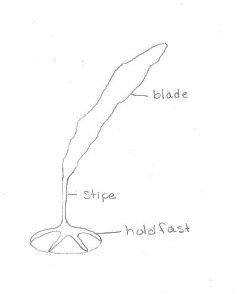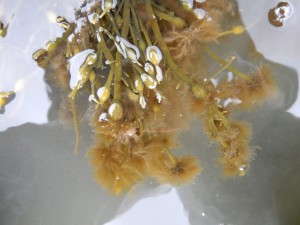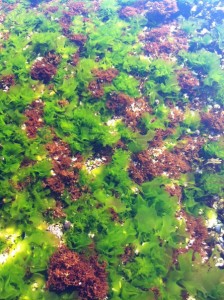Seaweeds are macroscopic (large) marine algae. There are three basic categories of seaweeds: greens (Chlorophyta) like sea lettuce, reds (Rhodophyta) like nori and Irish moss, and browns (Phaeophyta) like kelp. What separates these categories is more than just their color, which is controlled by the types of pigments they have, but also how their chloroplasts (the cell organelle responsible for photosynthesis) are structured, as well as their reproduction.
 Unlike land plants, seaweeds do not have roots, stems, and leaves. This is because seaweeds do not have a vascular system (xylem and phloem) that transports water and minerals around. Seaweeds are able to get their minerals directly from the water surrounding them. However, you may have noticed that seaweeds have structures that externally resemble roots, stems, and leaves. These structures are called holdfasts, stipes, and blades. Some seaweeds have many blades originating from a single stipe, and collectively they are called the frond. Many seaweeds also have small air bladders along their stipes or blades to help them stay afloat.
Unlike land plants, seaweeds do not have roots, stems, and leaves. This is because seaweeds do not have a vascular system (xylem and phloem) that transports water and minerals around. Seaweeds are able to get their minerals directly from the water surrounding them. However, you may have noticed that seaweeds have structures that externally resemble roots, stems, and leaves. These structures are called holdfasts, stipes, and blades. Some seaweeds have many blades originating from a single stipe, and collectively they are called the frond. Many seaweeds also have small air bladders along their stipes or blades to help them stay afloat.
Not all marine macroalgae are leafy. Some filamentous seaweeds look like masses of strings or threads while others are hard and encrusting.
 |
 |
| Elachista fucicola on Ascophyllum nodosum Photo by J. Muhlin |
Ulva lactuca and Chondrus crispus Photo by S. Redmond |
Seaweeds are primary producers in the ocean, using sunlight to capture carbon dioxide and make sugars through photosynthesis. Along with phytoplankton (microalgae), seaweeds form the basis of the food web in the ocean. In addition to providing food for marine animals, seaweeds also provide habitat. Their complex structure allows many invertebrates and fish to shelter under the canopy. Seaweeds are an integral part of the marine ecosystem.
As well as providing immediate food and shelter benefits to marine animals, seaweeds promote ocean health in other ways. Seaweeds capture carbon, helping to reduce ocean acidification, and release oxygen, increasing the dissolved oxygen available for animals. Because seaweeds absorb nutrients, like nitrogen and phosphorous, excesses of which can end up in the ocean from agricultural runoff, they help to reduce coastal eutrophication, which is harmful to fish and sometimes humans (e.g., red tides). Seaweeds can also remove other pollutants from the waters, such as organochemicals, heavy metals, and even TNT!
Despite their ability to soak up these pollutants, seaweeds growing in clean waters are not only very safe, but also very healthy for humans, being loaded with micronutrients and antioxidants. But, we use seaweeds for far more than just eating them whole. We use their extracts to make many types of foods and cosmetics. We also use them to feed our food on land. Seaweed fertilizers are commonly used in agriculture and many animal feeds contain seaweed components as well. Without seaweeds, our food supply would look very different.